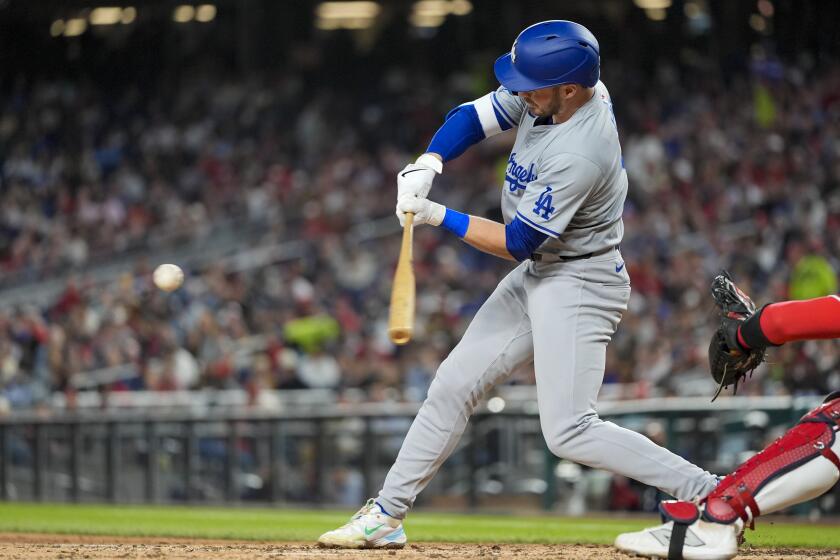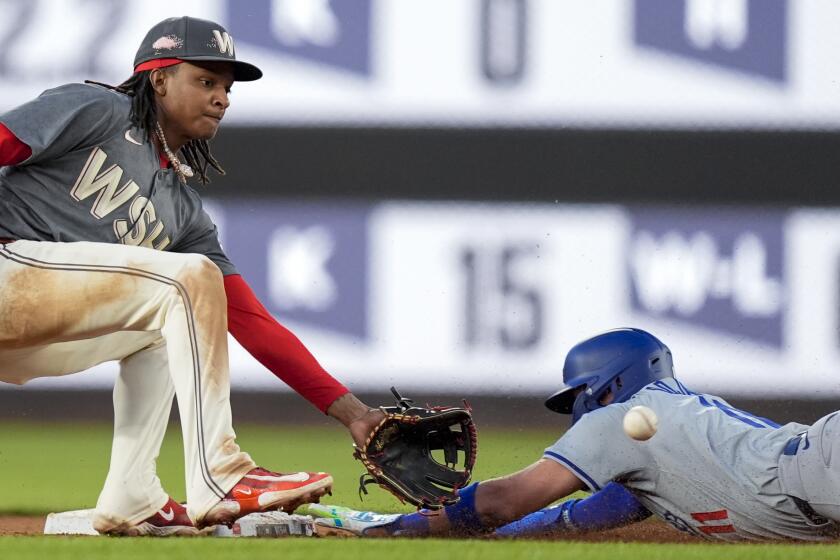Padres’ Control Artist Trying to Control His Life
Every shop, factory and office has a person no one else ever notices. This person does not make a show of anything, does not complain and does not, to anyone else’s perception, have a worry in the world.
This invariably is a person who is efficient to the point of almost being boring.
And this also is invariably a person who does the job better than anyone else.
In baseball, this person would sign autographs, pose for pictures with children, converse with the media and vote Republican. This person would not be outrageously quotable (or colorful), would not break bats in frustration and would not join a protest march.
The Padres have just such a player. It is not Steve Garvey, though the description probably fits.
This person is a fellow who would not miss anything he was supposed to ride, fly or hit, meaning a bus, airplane or a strike zone.
Meet LaMarr Hoyt. He is the guy who gets the job done, though hardly anyone knows when or how he does it.
After a particularly impressive outing last summer, teammate Dave Dravecky offered congratulations.
“For what?” Hoyt yawned.
“I don’t know,” Dravecky answered, perhaps at a loss to explain the specifics of the occasion.
That is the way it is when Hoyt is standing on the pitching mound. Not much happens. He does not strike fear into batters’ hearts, because they never seem to miss what he offers. However, they never seem to hit it very hard. Guys batting against Hoyt look like they are hitting grounders and fly balls so the Padres can practice their fielding without really exerting themselves.
To get Hoyt from the Chicago White Sox in the winter of 1984-85, the Padres gave up guys who made things happen. They surrendered a pitcher who might strike out nine, but lose because he allowed six walks and a pair of 400-foot homers, as well as an infielder who might score from first on a single, and then get picked off base in the eighth inning of a one-run game in the World Series. Those guys definitely made things happen.
What the Padres wanted was what they knew Hoyt would give them. A dull game every fourth or fifth day.
Remember the 1985 All-Star Game? You don’t? That’s not surprising. The National League won, 6-1, in a game which was about as exciting as waiting for a bus.
Most All-Star MVPs are guys who hit home runs off light standards, a la Roy Hobbs, or strike out the Hall of Fame, a la Carl Hubbell. This game’s MVP was a starting pitcher who worked three innings, gave up two hits, walked none and struck out none.
LaMarr Hoyt.
Walked none. That is LaMarr’s game. Control.
En route to last year’s 16-8 record, he walked all of 20 hitters in 210 innings. That is an average of 0.86 walks per nine innings, making him the most controlled pitcher in baseball. No one else gave up less than a walk per nine innings.
Hoyt did not walk a batter in 16 of his 31 starts in 1985, and gave up only intentional walks in two of the other starts. A batter’s children can grow up and graduate from college while waiting for Hoyt to walk him.
Of course, there are different ways to look at “control.” A lot of pitchers stay away from walks by laying fat pitches down the middle of the plate. Hoyt works the edges like he’s trimming hedges. His version of a “wild” pitch is anything either three inches outside or right down the middle. He doesn’t like to throw it either place.
It was surprising this spring to learn that so disciplined and efficient a worksman should find himself embroiled in a bit of controversy.
Hoyt had previous bouts with controversy when he pitched with the White Sox, mainly because he pitched with a paunch which made him a mountain on the mound. No one complained when he won 24 games with that paunch in 1983, but it became a burdensome beast when he lost 18 a year later. This was what prompted the White Sox to trade him.
This spring’s controversy, if indeed that is the best word, is a little different. He checked into the Padres’ training camp one day and departed soon thereafter to check into a rehabilitation facility.
LaMarr Hoyt had never had any trouble controlling a baseball, but he needed help controlling LaMarr Hoyt.
This was surprising, but it was even more surprising that Hoyt had encountered problems with the law in the weeks leading up to spring training. He had been stopped at the border with an assortment of pills in his possession and later arrested in San Diego and charged with possession of marijuana and a switch blade knife.
Obviously, this man had been battling some demons. He had probably been dealing with these demons like he deals with hitters, nibbling at the corners and trying to get them to get themselves out.
However, what works in baseball does not always work in life.
LaMarr Hoyt, the man, finally had to do what LaMarr Hoyt, the pitcher, abhorred. He had to come straight with it. This one had to be right down the middle. This would be the most important delivery of his life.
While his teammates were working in Yuma, Hoyt was where he felt he had to be rather than where he wanted to be. His opponent, as I understand it, was alcohol. This one hits a whole lot harder and a whole lot more often than a Pedro Guerrero or Dale Murphy.
Hoyt is back in uniform now, and the Padres soon will be handing him a baseball every four or five days and asking him to nibble at those corners and keep things dull. Just give the guys some fielding practice.
Of course, LaMarr Hoyt’s most important pitches will have nothing to do with baseball. In baseball, control means hitting the corners. In life, control means right down the middle.
This is a man who prides himself on control.
More to Read
Are you a true-blue fan?
Get our Dodgers Dugout newsletter for insights, news and much more.
You may occasionally receive promotional content from the Los Angeles Times.






